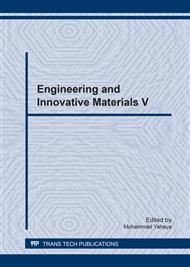p.191
p.195
p.201
p.209
p.215
p.221
p.229
p.234
p.239
Preparation and Characterization of Single and Mixed Activated Carbons Derived from Coconut Shell and Palm Kernel Shell through Chemical Activation Using Microwave Irradiation System
Abstract:
Single and mixed coconut shell (CS) and palm kernel shell (PKS) were successfully converted to activated carbon by using potassium hydroxide (KOH) as activating agent. Mixed activated carbon was produced from coconut shell: palm kernel shell at different KOH concentrations of 30%, 40% and 50%. Activation process was performed in a conventional microwave oven at fixed power and time of 600W and 20 minutes respectively. The results showed that activated carbon produced from single and mixed biomass at 40% concentration of KOH exhibited higher adsorption capacity for iodine number and percentage removal of MB with comparison to 30% and 50% of KOH concentrations. The highest BET surface area of 441.19 m2/g was obtained by CSAc-40. Further both CSAc-40 and PKSAc-40 produced an average pore size diameter of less than 2.0 nm which is in the range of micropore region. On contrary, the mixed CSPKSAc-40 produced an average pore size diameter of 6.0 nm which is in the region of mesopore. All the CSAc-40, PKSAc-40 and mixed CSPKSAc-40 showed similar adsorption trend for iodine number and percentage removal of MB. Interestingly, this finding showed that in the mixed activated carbon some chemical reactions might have occurred during the activation process producing mesoporous instead of microporous as obtained by the single biomass activated carbon.
Info:
Periodical:
Pages:
215-220
Citation:
Online since:
March 2017
Price:
Сopyright:
© 2017 Trans Tech Publications Ltd. All Rights Reserved
Share:
Citation:


